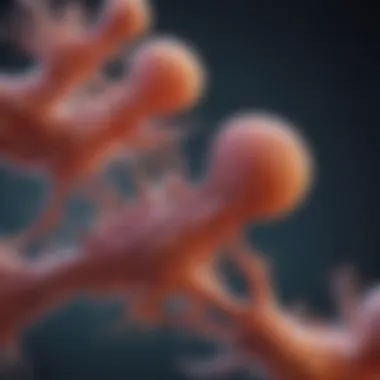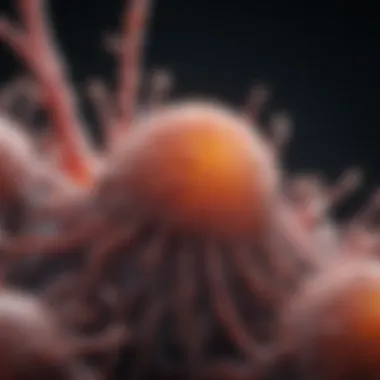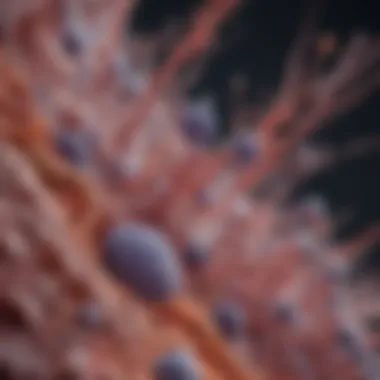Exploring Primary Fibroblasts: Insights and Applications


Intro
The examination of primary fibroblasts is crucial for understanding cellular mechanisms in both health and disease. These cells are fundamental components of connective tissues, playing significant roles in wound healing, tissue repair, and the response to inflammation.
Background and Context
Overview of the research topic
Primary fibroblasts are specialized cells responsible for synthesizing extracellular matrix, which provides structural support to tissues. Their importance extends beyond mere structural roles, as they actively participate in signaling, growth, and repair processes. Research into primary fibroblasts offers insights into various physiological and pathological conditions, including fibrosis, cancer, and aging.
Historical significance
The study of fibroblasts dates back to the mid-20th century when researchers began isolating these cells to understand their functions better. Advances in cell culture techniques allowed for the growth and manipulation of primary fibroblasts in laboratory settings. Historical studies have revealed how these cells respond to external stimuli and their ability to influence surrounding cells, contributing to advances in regenerative medicine and tissue engineering.
Key Findings and Discussion
Major results of the study
Recent studies have emphasized the diverse roles of primary fibroblasts. It is now well-established that these cells are not homogeneous; they exhibit varying characteristics based on origin, environmental conditions, and developmental stage. Understanding these variations is critical for utilizing fibroblasts in therapeutic applications.
Detailed analysis of findings
- Cell Isolation Techniques: Various methods have been developed for isolating primary fibroblasts, including enzymatic digestion and explant culture. Each technique bears implications for cell viability and functionality.
- Functional Characteristics: Primary fibroblasts retain a remarkable capacity for proliferation and differentiation. Their response to growth factors, such as transforming growth factor-beta (TGF-β), illustrates their role in fibrosis and tissue remodeling.
Primary fibroblasts are essential in deciphering the complex interactions in tissue regeneration and repair processes. Their capacity to adapt and respond to varying stimuli makes them invaluable in research.
- Applications in Research: From regenerative therapies to cancer research, primary fibroblasts serve as model systems. They assist in understanding pathological mechanisms and testing potential interventions.
- Future Directions: Potential future studies may focus on optimizing isolation techniques, understanding the mechanisms governing fibroblast heterogeneity, and developing advanced therapeutic strategies targeting these cells.
The significance of primary fibroblasts in cellular biology cannot be overstated. Their ability to influence a plethora of biological processes underlines their importance in advancing our understanding of health and disease. As research continues, it is expected that new findings will further elucidate the roles of these versatile cells in various medical applications.
Intro to Primary Fibroblasts
The study of primary fibroblasts is crucial for understanding various biological processes and their implications in health and disease. These cells play a fundamental role in the structure and function of connective tissues, contributing to tissue homeostasis and repair mechanisms. In research, primary fibroblasts are pivotal for elucidating cellular behaviors, pathologies, and responses to therapy. This article aims to provide insights into the characteristics and applications of primary fibroblasts, aiding researchers and students alike in navigating this vital part of cellular biology.
Definition and Role in Connective Tissue
Fibroblasts are the most abundant cells found in connective tissue. They are responsible for producing and maintaining the extracellular matrix (ECM), which provides structural and biochemical support to surrounding cells. Fibroblasts secrete collagen, elastin, and glycosaminoglycans, essential components of the ECM. Their activity is crucial during wound healing, as they proliferate and migrate to sites of injury, facilitating tissue regeneration. Understanding the definition and role of fibroblasts not only helps in learning about connective tissues but also emphasizes their impact on various disease states, including fibrosis and cancer.
Historical Background
The history of fibroblast research reflects its evolving significance in biology. Studies began in the late 19th century when cells were first identified in connective tissue sections. Early histological techniques allowed scientists to visualize these cells, although their functions remained unclear for some time. It wasn't until the mid-20th century that the understanding of fibroblasts advanced significantly, particularly in the context of tissue repair and remodeling. This foundational work laid the groundwork for modern research, where primary fibroblasts are now studied extensively in various biomedical fields.
Characteristics of Primary Fibroblasts
Understanding the characteristics of primary fibroblasts is crucial for researchers and educators. These cells are key players in the structure and function of connective tissues. Their specific traits contribute to various physiological processes and make them essential in numerous experimental contexts. Researchers employ this knowledge to utilize fibroblasts effectively in scientific inquiries.
Morphological Features
Primary fibroblasts exhibit distinct morphological features that set them apart from other cell types. Typically, they present a spindle-like shape with elongated nuclei. These features are vital for their functions in connective tissue. The fibroblasts’ cytoplasm is often abundant, allowing for the production and secretion of extracellular matrix components. This matrix is instrumental for tissue integrity and repair.
The morphology can vary depending on the tissue source from which the fibroblasts are derived. For instance, skin fibroblasts may appear different than lung fibroblasts due to their specific environmental adaptations. Changes in morphology can also reflect the state of cellular proliferation or differentiation. Researchers need to recognize these variations to ensure proper analysis and interpretation of data.
Molecular Markers
Molecular markers are essential for identifying and characterizing primary fibroblasts within different environments. Key markers include proteins such as fibroblast-specific protein 1 (FSP1) and vimentin. These markers indicate the fibroblast's status and functionality. Detection of these markers can help distinguish fibroblasts from other cell types, which is especially important in research settings.
In addition, profiling fibrotic responses through the expression of specific markers provides a means to assess the activation state of fibroblasts in pathological conditions. Understanding these molecular markers aids researchers in appropriately targeting fibroblasts in therapeutic approaches or investigational studies, enhancing the relevance of their findings.


Functional Properties
The functional properties of primary fibroblasts underscore their roles in healing, support, and tissue regeneration. These cells are responsible for synthesizing collagen and elastin, which are critical structural proteins in connective tissues. Moreover, fibroblasts produce a variety of growth factors and cytokines that facilitate communication between different cell types within tissues.
Furthermore, fibroblasts can exhibit contractile activity, which is pivotal in wound healing. This property allows them to contribute to tissue remodeling by improving tensile strength. The versatility of fibroblasts makes them valuable in a broad spectrum of research areas, including cancer, fibrosis, and regenerative medicine.
Primary fibroblasts are indispensable in understanding many cellular processes and their subsequent effects on human health.
In summary, the characteristics of primary fibroblasts—ranging from their morphology and molecular markers to their functional properties—provide essential insights into their roles in health and disease. Recognizing these features empowers researchers to harness fibroblasts effectively in various scientific and clinical applications.
Isolation and Culture of Primary Fibroblasts
The isolation and culture of primary fibroblasts hold significant importance in both basic and applied research. These processes enable scientists to study cellular properties in controlled environments, allowing for more accurate experimental results. By understanding how to effectively isolate and culture fibroblasts, researchers can investigate their roles in health and disease, ultimately leading to advancements in medical science.
Tissue Sources
Skin
Skin serves as a primary source of fibroblasts due to its abundant presence in the body. The dermis, the skin's inner layer, contains a vast population of fibroblasts that produce collagen, elastin, and other essential components of the extracellular matrix. The key characteristic of skin fibroblasts is their ability to regenerate and respond to tissue injury. This makes skin a popular choice for isolation, especially in wound healing studies.
However, working with skin fibroblasts has its challenges. The isolation process can be invasive, leading to potential complications. Additionally, fibroblasts from aged skin may demonstrate altered functionality compared to those from younger donors. Nevertheless, skin fibroblasts remain valuable for understanding tissue repair mechanisms.
Lung
Lung fibroblasts are crucial in the study of pulmonary diseases and remodeling processes. These fibroblasts are primarily found in the lung interstitium and play a role in maintaining normal lung function. Their significance lies in their involvement in the pathophysiology of conditions such as pulmonary fibrosis and asthma.
One of the benefits of using lung fibroblasts is their responsiveness to growth factors, making them an excellent model for studying cellular responses to inflammation. However, the isolation of lung tissue can be more complex compared to skin, often requiring specialized techniques to preserve cell viability.
Heart
Heart fibroblasts contribute to cardiac health and pathology. These cells are found in the myocardium and play a pivotal role in maintaining cardiac structure and function. The key aspect of heart fibroblasts is their involvement in the fibrotic response after injury, such as myocardial infarction.
Their isolation is advantageous for cardiac research, particularly for understanding heart repair mechanisms. However, heart fibroblasts exhibit significant heterogeneity. This variability can complicate interpretations of experimental data, as distinct fibroblast subtypes may respond differently to stimuli.
Isolation Techniques
Enzymatic Digestion
Enzymatic digestion remains a widely used technique for isolating primary fibroblasts from various tissues. This method involves using specific enzymes, such as collagenase or dispase, to break down the extracellular matrix, allowing fibroblasts to be freed from their native environment. The key characteristic of enzymatic digestion is its effectiveness in yielding high cell viability and purity.
Its popularity in this article comes from its relatively straightforward application in various tissues. Nonetheless, careful optimization is required to prevent damage to the cells, as excessive enzyme exposure can lead to cell death or altered functionality.
Centrifugation
Centrifugation is another isolation technique that utilizes centrifugal force to separate cells based on density. It is often used following enzymatic digestion to further purify isolated fibroblasts. The process allows researchers to obtain a concentrated population of fibroblasts while removing debris and other cellular components.
The key advantage of centrifugation is its speed and efficiency, making it a practical choice in laboratories. However, it may not be suitable for all tissue types, and the force applied must be carefully controlled to avoid damaging fragile cells.
Microdissection
Microdissection is a surgical approach for isolating fibroblasts from specific areas within tissues. This technique can provide highly specific cellular samples, facilitating the study of localized responses. The unique feature of microdissection is its ability to maintain the spatial context of fibroblasts, which can be crucial for studying their interactions with surrounding cells.
While microdissection can be beneficial, it is also labor-intensive and requires skill. Additionally, the process may yield fewer cells, which can limit the scope of downstream applications.
Culture Conditions
Nutrient Requirements
To effectively culture primary fibroblasts, specific nutrient requirements must be met. These cells demand a nutrient-rich medium containing amino acids, vitamins, and glucose to support their metabolic needs. This specificity allows researchers to create optimal growth conditions that facilitate fibroblast proliferation.


The inclusion of appropriate nutrients enhances cell viability and functionality, making it a beneficial aspect for research. Nevertheless, maintaining the right nutrient balance is essential, as deficiencies can lead to diminished growth or altered cellular behavior.
Growth Factors
Growth factors play a critical role in the culture of fibroblasts, influencing cell proliferation and differentiation. Factors such as fibroblast growth factor (FGF) and transforming growth factor-beta (TGF-β) can stimulate fibroblast activity. Their pivotal role in the culture environment makes them essential for promoting healthy cell behaviors.
Incorporating growth factors into culture media can significantly enhance cellular responses, thus supporting various experimental objectives. However, excessive concentrations may lead to unintended effects, emphasizing the need for optimization.
Substrate Considerations
The choice of substrate is another critical element in fibroblast culture. Fibroblasts attach to specific substrates, which influences their behavior and functionality. Common substrates include tissue culture polystyrene and extracellular matrix proteins.
This choice impacts cell morphology and gene expression, highlighting its importance in research settings. Despite the variety of options, the right substrate must be selected according to the specific experimental goals. Inappropriate choices can result in compromised cell performance or altered responses.
Applications of Primary Fibroblasts in Research
Primary fibroblasts play a significant role in various scientific studies. They provide vital information about tissue repair, response to drugs, and cancer biology. The study of these cells is crucial for a deeper understanding of underlying mechanisms involved in health and disease. Their versatility has made them an important focus in areas such as regenerative medicine, drug screening, and disease modeling.
Wound Healing Studies
Wound healing is a complex process that requires the coordinated actions of various cell types, including fibroblasts. These cells are essential for synthesizing extracellular matrix proteins, which provide structural support. Fibroblasts contribute to the healing process by migrating to the site of injury, proliferating, and producing collagen. Studies utilizing primary fibroblasts allow researchers to explore the cellular and molecular pathways involved in tissue repair.
Recent findings show that fibroblasts exhibit a phenotypic change during healing, developing properties that promote repair. Understanding these changes can lead to improved treatments for wounds that do not heal properly. A growing body of evidence suggests that manipulating fibroblast behavior can enhance wound healing in diabetic patients and those with chronic wounds.
Cancer Research
The role of fibroblasts in cancer research is increasingly recognized. Tumor-associated fibroblasts interact with cancer cells, influencing tumor growth and metastasis. These interactions create a complex microenvironment that can affect drug response and disease progression. By studying primary fibroblasts, researchers can investigate the mechanisms of tumor-stroma interactions and discover potential therapeutic targets.
For example, fibroblasts can secrete growth factors that aid in tumor growth. Targeting these factors could lead to more effective cancer treatments. Furthermore, the characterizations of cancer-associated fibroblasts contribute significantly to understanding different cancer types and their behaviors.
Drug Development
In drug development, primary fibroblasts serve as a platform for screening new compounds. These cells help assess drug efficacy and toxicity, which is essential for developing safe and effective therapies. Using fibroblasts in preclinical models allows scientists to test how various drugs perform in a biological system that closely mimics human physiology.
Moreover, fibroblast responses can reveal insights about adverse drug reactions. Observing how these cells react to different compounds can inform researchers about potential side effects and help guide modifications to drug formulations.
Tissue Engineering
Tissue engineering relies heavily on fibroblasts for creating functional tissues. By seeding primary fibroblasts onto scaffolds, researchers can develop new therapies for tissue repair or replacement. These cells are crucial for producing the extracellular matrix needed for tissue integrity. Their ability to proliferate and differentiate offers the potential for regenerating damaged tissues.
In addition, combining fibroblasts with stem cells in engineered tissues can enhance functionality and integration. This combination is key in generating tissues that closely resemble natural structures. Advances in biomaterials have further facilitated the application of primary fibroblasts in creating complex tissue constructs.
"Understanding the application of primary fibroblasts across diverse research areas helps bridge gaps in scientific knowledge and fosters innovation in medical science."
Challenges in Fibroblast Research
Research on primary fibroblasts presents unique challenges that impact the validity and reproducibility of results. Understanding these challenges is crucial for advancing our knowledge of fibroblasts and their applications in various fields. This section will delve into specific issues like cellular senescence, genetic variability, and contamination issues, each of which plays a significant role in fibroblast research.
Cellular Senescence
Cellular senescence refers to the process where fibroblasts cease to divide and enter a state of permanent growth arrest. This phenomenon is significant in aging and tissue repair. A major challenge arises when studying fibroblasts in vitro, as senescent cells can alter their secretome. This change may skew research outcomes, leading to misinterpretation of data. Additionally, identifying and distinguishing senescent fibroblasts from actively proliferating ones presents difficulties. Researchers need to employ specific markers to accurately assess senescence.
- Senescence can influence:
- Wound healing: Impaired ability to respond to injuries.
- Cancer progression: Altered tumor microenvironment due to senescent cells.
- Aging research: Insights into age-related diseases.
Genetic Variability


Genetic variability among fibroblast populations complicates research efforts. Variability can arise from different tissue sources, individual donors, or even environmental influences. This genetic diversity can lead to inconsistent responses to stimuli or treatments. Thus, research findings may not be universally applicable. Understanding the genetic background of specific fibroblast lines becomes essential in interpreting experimental results.
- Key factors of genetic variability:
- Source tissue: Fibroblasts from skin may behave differently than those from lungs.
- Donor age and health: Variations based on age, health status, or genetic predisposition.
Contamination Issues
Contamination poses a critical risk during fibroblast culture and analysis. Bacterial, fungal, or mycoplasma contamination can significantly affect cell viability and functionality. Such issues can lead researchers to misinterpret results, ultimately skewing their findings. Strict aseptic techniques are vital when isolating and culturing fibroblasts. Regular testing for contaminants is also necessary to ensure the integrity of experimental data.
"Contamination not only affects the cells themselves but also compromises the entire experimental setup, making findings unreliable."
Researchers must remain vigilant and proactive in maintaining clean lab environments. This vigilance includes thorough cleaning, proper storage, and monitoring cell cultures for signs of contamination.
In summary, tackling challenges like cellular senescence, genetic variability, and contamination is essential for advancing fibroblast research effectively. Addressing these issues ensures that findings are reliable and can inform future studies and applications.
Future Directions in Fibroblast Research
The ongoing exploration of primary fibroblasts presents significant avenues that could enhance our understanding of various biological processes and disease mechanisms. This section discusses the potential future directions in fibroblast research, focusing on novel methods for isolation, the role of genetic editing, and the integration of fibroblast studies with regenerative medicine. Each topic holds the potential to not only advance scientific knowledge but also to lead to practical applications in health care and below are some key elements to explore.
Novel Isolation Techniques
As researchers aim to study fibroblasts more efficiently, novel isolation techniques are gaining traction. Traditional methods such as enzymatic digestion and mechanical disaggregation often lead to heterogeneous populations with variable characteristics.
Recent advancements, such as microfluidics, are enabling more precise isolation methods that can yield a high-purity fibroblast population. These innovations benefit researchers by providing access to better defined cell types. Techniques like laser capture microdissection and fluorescence-activated cell sorting (FACS) are also showing promise in isolating these cells while preserving their functional properties.
"Improved isolation techniques could allow researchers to study fibroblasts in ways previously considered impossible."
Such techniques pave the way for more accurate experimental setups, ensuring that findings are more relevant and reproducible across various studies.
Genetic Editing Applications
The advent of CRISPR and other genetic editing technologies is transforming biomedical research, and fibroblasts are no exception. With the ability to precisely manipulate specific genes, scientists can explore how particular genes influence fibroblast behavior in different contexts. Genetic editing can enable researchers to construct models of fibrosis or other diseases directly involving fibroblasts.
Moreover, genetic modifications can help in understanding cell behavior under pathological conditions. For example, reducing the expression of certain pro-inflammatory markers in fibroblasts can lead to insights into chronic inflammation-related diseases. As these technologies continue to advance, the potential applications in this area will expand, contributing meaningfully to personalized medicine and tailored therapeutic strategies.
Integration with Regenerative Medicine
Fibroblasts are integral to tissue repair and regeneration, making their study significant in regenerative medicine. As research progresses, the capture and application of fibroblasts in therapeutic contexts is becoming more feasible. For instance, fibroblast-derived extracellular matrix can serve as a scaffold for tissue engineering applications.
The combination of fibroblasts with stem cells is another exciting area. This integration can potentially enhance tissue regeneration processes and improve healing outcomes. Clinical trials are already exploring the effects of fibroblast therapies in treating conditions such as cardiac injury and skin wounds.
- Researchers are starting to understand the mechanisms by which fibroblasts communicate with other cells in the tissue environment, making these cells a vital focus for future investigations.
Finale
The conclusion serves a critical role in synthesizing the information presented throughout the article. It enables a comprehensive reflection on the significance of primary fibroblasts, accentuating their relevance across various fields of research. This section crystallizes the merits of understanding primary fibroblasts, which are vital components of connective tissue and play essential roles in processes such as wound healing, tissue repair, and disease pathology.
In summarizing the key points, it is essential to revisit the major characteristics, isolation methods, and applications of primary fibroblasts. These attributes not only highlight their unique functionalities but also underscore the challenges encountered in research, including cellular senescence and genetic variability. Engaging with these challenges is necessary, as they influence both the potential and the limits of fibroblast research.
As researchers invest time into understanding the mechanisms underlying fibroblast behavior, the benefits become evident. Accurate assessment of fibroblasts enhances the development of effective therapeutic strategies, paving the way for advancements in regenerative medicine and other health-related fields. Further, the efforts to innovate isolation techniques or utilize genetic editing may unlock new applications, reinforcing the necessity of continuous exploration.
Thus, the conclusion of the article does more than summarize; it posits that primary fibroblasts are integral to advancing scientific knowledge and medical practice. By reflecting on the implications of these findings, we recognize the importance of primary fibroblasts as a focal point in both current and future investigations.
Summary of Key Points
- Primary fibroblasts are crucial for connective tissue structure and repair.
- Their characteristics include unique morphological and molecular properties.
- Isolation techniques have evolved, enhancing culture and study methods.
- Applications span various research fields, particularly wound healing and cancer research.
- Challenges in research include senescence and genetic variability, which must be addressed for effective applications.
- Future directions in research should focus on novel isolation techniques and genetic editing applications.
Implications for Future Research
The implications of fibroblast research are profound. As technology progresses, possibilities expand. Researchers should consider the integration of advanced techniques such as CRISPR for genetic editing. This approach could lead to tailored therapies addressing individual patient needs. Furthermore, integrating fibroblasts with tissue engineering could yield significant breakthroughs in regenerative medicine applications.
Investing in understanding the cellular mechanisms of fibroblasts may facilitate innovations not only in basic research but also in clinical practice. The insights from ongoing studies could ultimately inform treatment protocols, enhancing healing processes and improving patient outcomes.
As we look ahead, it remains crucial to foster collaboration between researchers and clinicians. This partnership can expedite the translation of laboratory findings into practical applications, thereby enriching the fields of health and disease management.







